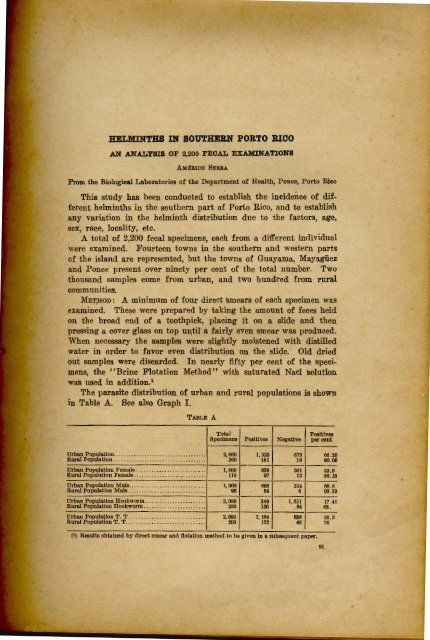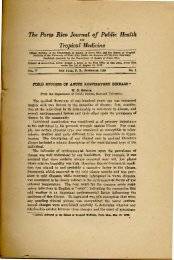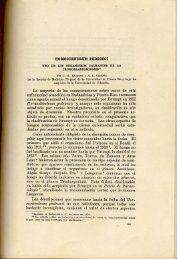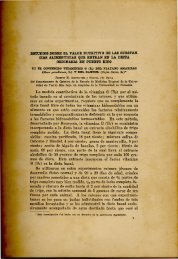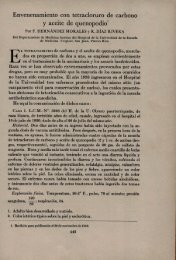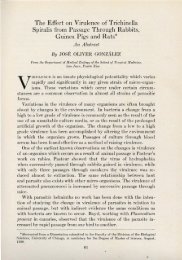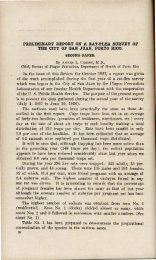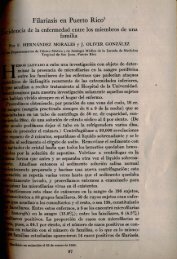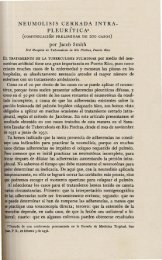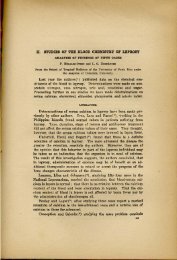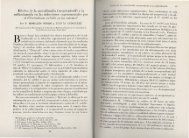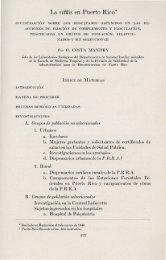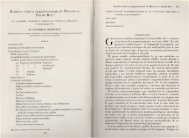Helminths in Southern Porto Rico
Helminths in Southern Porto Rico
Helminths in Southern Porto Rico
You also want an ePaper? Increase the reach of your titles
YUMPU automatically turns print PDFs into web optimized ePapers that Google loves.
HELMINTHS IN SOUTHERN PORTO RICO '<br />
AN ANALYSIS OF 2,200 FECAL EXAMINATIONS<br />
AlltRICO SERRA<br />
From t he Biological Laboratories of the Department of Health, Ponce, <strong>Porto</strong> <strong>Rico</strong><br />
This study has been conducted to establish the <strong>in</strong>cidence of different<br />
helm<strong>in</strong>ths <strong>in</strong> the southern part of <strong>Porto</strong> <strong>Rico</strong>, and to establish<br />
any variation <strong>in</strong> the helm<strong>in</strong>th distribution due to the factors, age,<br />
sex, race, locality, etc.<br />
A total of 2,200 fecal 'specimens, each from a different <strong>in</strong>dividual<br />
were exam<strong>in</strong> ed. F ourteen towns <strong>in</strong> the southe rn and western parts<br />
of the island are represented, but the towns of Guayama, Mayagiiez<br />
and Ponce present over n<strong>in</strong>ety per cent of the total number. Two<br />
thousand samples come from urban, and two hundred fro m rural<br />
communities.<br />
ME1;HOD:<br />
exam<strong>in</strong>ed.<br />
A m<strong>in</strong>imum of four direct 'smears of each specimen was<br />
These were prepared by tak<strong>in</strong>g the amount of feces held<br />
on the broad end of a toothpick, plac<strong>in</strong>g it on a slide and then<br />
press<strong>in</strong>g a cover glass on top until a fairly even smear was produced.<br />
When necessary the sample's were slightly moistened with distilled<br />
water <strong>in</strong> order to favor even distribution on the slide. Old dried<br />
out samples were discarded. In nearly fifty per cent of the specimens,<br />
the " Bri ne Flotation Method" with saturated Nael 'solution<br />
was used <strong>in</strong> addition.'<br />
The parasite distribution of urban and rural populations is shown<br />
<strong>in</strong> Table A. See also Graph I.<br />
TABLE A<br />
Total<br />
Positives<br />
Specimens Positives Negative per cent<br />
Urban Population.. .. .. . ....... . .. .......... . . . . .... . 2,000 1,325 67S 66.25<br />
Rural Population. . .. . .... .. . .. .. . . . . . . . . . .. . .... .. .. 200 181 19 90. 015<br />
Urban Population Femal e. ..... .. ... ............ . '" 1,000 639 361 63.9<br />
Rural Population Female............ .... .. ... . .... . 110 117 13 88 .18<br />
Urban Population Male.. ... . . . . . .. . . . . ...... . . .. .... 1,000 ll8II 314 68.6<br />
Rural Population Male.. ........................... . 90 84 6 93.33<br />
Urban Population Hookworm .. .... . . . . .. . . . . . .. .. .. . 2,000 349 1. Ml 17.4~<br />
Rural Population Hookworm . . . .. . . . . . .. . .. .. ..... .. 200 136 64 68.<br />
Urban Population T. T ... ................ ... . . ..... . 2,000 1,164 836 68.2<br />
Rnral Population T . T ... ..... .. .. .............. .. .. 200 1 ~2 48 76<br />
(I) RelDlt.'! obta<strong>in</strong>ed by d irect smear an d flota tion method to be gl.,en In a subseq uent paper.<br />
91
92 PORTO BIOO JOURNAL OJ' PUBLIO HEALTH AND TBOP. HEDICINK<br />
Among the samples from urban population there were 285 from<br />
colored <strong>in</strong>dividuals with sixty-six and two-thirds per cent positive.<br />
Of these 140 were from male's wit h seventy per cent positive, and<br />
145 females with 63.5 per cent posit ive. ·These percentages of positives,<br />
as well as those obta<strong>in</strong>ed for hookworm and Trichuris triehura<br />
were <strong>in</strong>credibly close to the figures obta<strong>in</strong>ed for white <strong>in</strong>dividuals of<br />
correspond<strong>in</strong>g sexes. Of the 1,325 positive urban sampl es, 438 had<br />
two or more parasites and only seventy had th ree or more. .The follow<strong>in</strong>g<br />
table shows the comb<strong>in</strong>ation of parasites <strong>in</strong> two th ousand<br />
urban specimens.<br />
TABL E B<br />
P ercen tage<br />
K <strong>in</strong>d of PlU'asJte Fem&!e Male Tot&! Positive<br />
1. Trlcb~ tri ehnra .<br />
2. Hookworm. Trlohuris trlc bura .<br />
3. Hookworm .<br />
4. Ascaris Inmbrfcoldes , Trlcb~ trlchura .<br />
5. Schistosoma mansoni , T richuri s tricbura .<br />
6 . Bchistosom t. manson!.. ..<br />
7. Hoolnmrm, Schistosoma mansonl T rich ur is trl cbura .<br />
8. T richu ris trlehura, StronlO'lold89 Intest<strong>in</strong>alls .<br />
9 Hookworm, Ascaris lumbrlcoldes Trichuris trlchura .<br />
10. ASClU'1s In mbrlcoldes .<br />
11. Hookworm . Strongyloides Intestlna lls. Trichur is tri ehurt.<br />
. .. .. . .. .. . . .. .. .. . .. .. . .. .<br />
12. Tenia nana , Trichuris trlchura.. .. .... .. ... . ....... .. ..<br />
13. Strongyloides Intest<strong>in</strong>alIs.<br />
14. Hookworm, Strongyloides Intest<strong>in</strong>&1is. . . .. . . . . .. . . . .. . .<br />
16. Hookw orm , Scblstosom a ma nsonl<br />
16. AsClU'ls lumbrieofdes, Schistosoma mansonl, Tri c h~<br />
tr lchura .<br />
17. Asesr ls Inmbrlcoldes, lTookworm .<br />
18. Hookworm, Schistosoma mansoni Strongyloides lutest<strong>in</strong>Blls,<br />
Trichuris trichum .<br />
19. Schistosoma mansonl, Strongyloides Intest<strong>in</strong>aUB, T rI·<br />
390<br />
3~7<br />
89 94<br />
37 61<br />
34 22<br />
24 66<br />
3 21<br />
9 12<br />
7 14<br />
10 II<br />
10 7<br />
6 II<br />
3 6<br />
6 3<br />
2 6 . 6<br />
747<br />
183<br />
88<br />
66<br />
80<br />
24<br />
21<br />
21<br />
19<br />
17<br />
14<br />
8<br />
8<br />
7<br />
6<br />
37.3S<br />
IUS<br />
4 .4<br />
2 .8<br />
4<br />
1.2<br />
1.06<br />
1.06<br />
. ~<br />
•lIS<br />
churls trlchura . 1 2 3 . IS<br />
20. Schlstosoma maosoni, Strongyloides tntest<strong>in</strong>alis . 2 1 3 .15<br />
21. Tenia nana . 2 .. 2 . 10<br />
22. H ooll:worm .Ascar i. lumbrlcoides Schistosoma mansont,<br />
Tricburlq trlchura . 2 2 .10<br />
23. Schistosoma mansonI,Hookworm Tenia naDa. Stronr y·<br />
Ioldes Intestln811s, Trichuris trichura . . . . . . . . . . . . . . . . . . . . . I 1 .OS<br />
24. T enia sag<strong>in</strong>ata, Strongyloides Intestlnalls . 1 1 .06<br />
25. Tenia sag<strong>in</strong>atR . 1 1 .05<br />
26. Hoo kworm Schistosoma manson! Asear!sltmlbrioolde8,<br />
Stro ngyloides IntestlnaUB. Trichur is trlehnra . 1 1 .06<br />
Total .. .. ... 639 - - -·t-- - - I-- - -<br />
686 1. 32.'l 841.26<br />
2<br />
3<br />
3<br />
1<br />
3<br />
6<br />
4<br />
4<br />
.70<br />
.40<br />
.40<br />
. 3.5<br />
. 2.5<br />
.2.5<br />
.20<br />
20
HELMINTHS IN SOUTHERN PORTO RICO 93<br />
By age groups the urban sample's were distributed as shown <strong>in</strong><br />
the follow<strong>in</strong>g table:<br />
TABLE C<br />
PARASITE DISTRIBUTION IN 2,000 URBAN SPECIMENS<br />
,;a<br />
., ., @ eO ..<br />
.. .e ~~ ~ .!!l.Q<br />
il § ~ ..<br />
Aie ;l .t:l"il<br />
]<br />
oW<br />
o -r- " ...<br />
..!l ~<br />
~ i 0 -;::.t: s ~§ 0
94: PORTO RICO JOURNAL OF PUDLIO HEALTH AND TBOP. lIlIlDIO~<br />
TABLE E<br />
PARASITE DIST:BIBUTION IN 1,000 URBAN SPECIMENS-FEMALE<br />
., ., E1§ ..<br />
e- ·~S ~ ;;<br />
!3", oa<br />
Age ] .~~<br />
,, ~<br />
~ .Sl il!l6 '" .!1~ l'l,.,<br />
COl<br />
"<br />
J:l<br />
i ;<br />
~ Z Eo<<br />
~ -.:.!:l 8 ~.a<br />
Eo<<br />
= -"l " ~.!:l .,1:1<br />
.,'" "' ..<br />
Eo< Eo<<br />
- - -- --I- - - '" - ------ '" <br />
Und er 1 fe!ll'. . .... . . . . ... . . .. .. . .. . . . 2 2 ...... ...... ...... ...... ......<br />
1 t o 2 ye ars.. ... .. . . . . . . . . . . . .. .. . .. . 10 2'l 32 8 ..... . 4 ... ... ..... . ...... ......<br />
2 t0 5 yoars . . . . . . . . . . . . . • . . .. •. .• . . .. 2'1 28 50 21 3 6<br />
··..G· ......<br />
5 t o 10 years... ... . . . .. . .. . .. ...... .. 2llO 120 410 274 41 23 ' '' 22' 9 ......<br />
10 to 20 ye",s . .. .. .. .. . ... . .. . ... .. . . . 200 94 294 172 63 26 16 6 ...... ......<br />
20 to 30 years . .. . . .. . . . . .. . .. . ... . . . .. 81 51 132 66 37 ...... 7 ...... ......<br />
30 t o 40 years.. .......... ............. 25 29 M 24 II ...... 2 ...... ...... ......<br />
40 to 50 years.. . . .. . .. . .. .... .. .. . .... 7 9 16 6 1 ...... ...... ...... ...... ......<br />
50 t o 60 years.. . ......... .. . .. . . .. . ... 2 3 s 2 ...... ...... ...... ...... ...... ......<br />
Over 60 years ... .. . . .. . ...... . . .. .. .. 2 3 5 2 ...... ...... ...... ..... . ...... ......<br />
--- - ----- - - - - -------<br />
- - --- - - - ~ - - - - - - - - --<br />
Tolal . . . .. . . . . , . .. . .. . . .. .. .. . . 639 361 1,000 1175 156 59 40 22 6 0<br />
In per cen t . .. . .. . . . ... .. . .. . . ........ 63.9 36.1 100 5 75 15 .6 5.9 4 2. 2 .6 ......<br />
Comparison of the results shown <strong>in</strong> tables C. D. and E. <strong>in</strong> percentage<br />
equivalents will be readily understood by reference to the<br />
follow<strong>in</strong>g graphs:<br />
Graph II for total number of positives<br />
Graph III for Trichuris triehura<br />
Graph IV for Hookworm<br />
Graph V for Ascaris lumbricoides<br />
Graph VI for Schistosoma mansoni<br />
There was a total of 916 specimens from Guayama; 444 females<br />
and 472 male's. For distribution by age groups and sexes see tables<br />
F' and G.<br />
PARASITE DISTB.IBUTION IN 444 SAl\fPLES FB.OM GUAYAMA<br />
FEMALE<br />
..e "<br />
., ., .~f a;;<br />
..<br />
~ ~ "<br />
Age ,J; ~ ~~<br />
! . §~ ,,~<br />
...<br />
-;;:;<br />
s:5<br />
o -r<br />
.!l~ ""<br />
S ·~<br />
~ ., Cl 'cb ""8 'U J:l g.!:l ,," .,c I.l=<br />
~ Z Eo< Eo< III -< " ~ Eo<<br />
- -I--------- '" '" -<br />
~<br />
Under 1 ycsr.. .. .... . . .. .. ... . .. .... . .. ..3· ... .2" ...... ...... .... .. ...... ...... ... ...<br />
1 to 2 years.. . . .. . .. . . .. .. . . . .. . .. . .. 2 1 ...... ...... ...... ...... ...... ......<br />
2to 5 years.. . . ................... . . . 4 4<br />
,"2.j· ....G· ......<br />
H o to years.. . . .. . .. . . . .. .. .. . . . .. . . :rll 88 300 .·2i. · 30 17 3 ......<br />
10 to 20 years. . .. . .. . . .. . . . . . .. . . .. . . . 86 28 114 80 25 7 16 ...... ...... ......<br />
20 t o 30 years.. . ..... . .. .. . ...... .. .. . 3 II 8 2 2 ...... ...... ...... ...... ......<br />
30 to 40 yOlll'll.. .. . . ...... .. . ...... . ... 2 3 5 2 1 ...... ...... ...... ...... ......<br />
40 to 50 years.. . . .. . . •• . •• . . .. . ... . . •. ...... .... i ...... ...... ...... ...... ...... . . --, . ......<br />
60 to 60 years... .. . . . . . .. .. .... . . . . . . . ...... 1 ...... ...... ...... ...... ...... ...... ......<br />
Over 60 years . . . . . . . .. .. . . . ... .. .. . .. ...... ...... ...... ...... ...... ...... ...... ...... ...... .......<br />
--- - - - - - --- - - - - - - - - -<br />
Tol.al. . . . . .. .. .......... . .. . . .. 314 130 444 300 58 24 40 6 3 -.....
HELMINTHS IN SOUTHERN PORTO RICO 95<br />
T.AJlLB G<br />
PARASITE DISTRIBUTION IN 472 SPEOIMENS FROM GUAYAMA<br />
MALE<br />
Age ~ ..<br />
., .... .. Il a., ceg<br />
.. -ctl 0<br />
: to ,t,j.o o~<br />
~ :0""<br />
..<br />
.lol .:/lIla =.. ·dl<br />
·s lll' ~ "" " ~ ~<br />
~b .
96 PORTO RICO JOURNAL OF PUBLIC HEALTH AND TROP. HEDIOINJI<br />
TABL E I<br />
PARASITE DISTRIBUTION IN 277 SPECIMENS FROM PONCE-MALE<br />
~.~<br />
.!l '" ~ ~<br />
.::: " ....c iJ E<br />
",.:;j<br />
A ge ~<br />
" °iO<br />
... ;; ... .- E .;,~I!J ..<br />
~~ "..; .!i~ '"<br />
] ~ ($ ';::: Eo 8 ..c --~<br />
~ ~ 0"<br />
p.. % E- 1;:>-<<br />
Eo O; ....
H EL MINTHS I . ' SOUT HERN PORTO It WO 97<br />
TABL E K<br />
PARASITE DISTRIBUTION IN 235 SPECIMENS FROM MAYAGUEZ<br />
MALE<br />
_ ~ Ii<br />
ceE<br />
i: ~<br />
0<br />
'" .:: " 5<br />
"'::1<br />
::I.e iI' .~ .ci ~; to<br />
~
98 PORTO -RICO JOURNAL OJ' PUBLIC HEALTH AND TBOP. MEDICINB<br />
tions exist for its development and for <strong>in</strong>festation of the barefooted<br />
population, that its figur es come anywhere near th ose of <strong>in</strong>festation<br />
with Trichuris trichura, (See Graph 1.) Due to this larval development<br />
<strong>in</strong> the ground we f<strong>in</strong>d a very low rate of <strong>in</strong>festation <strong>in</strong> ehildren<br />
of urban population. (See Graph IV.)<br />
Parasite <strong>in</strong>festation with most helm<strong>in</strong>ths predom<strong>in</strong>ates <strong>in</strong> th e<br />
uiale sex, especially so, after the first decade of life. This pre dom<strong>in</strong>ance<br />
is most marked <strong>in</strong> the case of parasites requir<strong>in</strong>g a stage of<br />
development outside th e human body. Our figures demonstrate this<br />
very well, except <strong>in</strong> the case of Ascaris Iumbricoides where the <strong>in</strong>cidence<br />
is a little higher for females th an for males. (See Graph V. )<br />
This sexual difference <strong>in</strong> <strong>in</strong>cidence appears most marked for<br />
Schistosoma Mansoni. (See Graph VI.) The reason for this is evident<br />
if we stop to consider the cycle of development of the ehistosoma<br />
mansoni egg outside the human body. ·The egg hatches <strong>in</strong> water and<br />
the myracidium swims toward the light, seek<strong>in</strong>g its proper snail host.<br />
If successful it enters the feelers of a fresh wat cr snail (planorbis)<br />
and is developed <strong>in</strong>to a sporocyst <strong>in</strong> three to four days' time. At<br />
the end of the fifth to sixth day this forms daughter sporocysts which<br />
migrate to the hepato-panereas about the twentieth day and form<br />
t ubular branches. The cer cari ae form <strong>in</strong> these daughter spor oeysts.<br />
Under proper <strong>in</strong>fluence of sun and heat the cercar iae escap e from<br />
the snail and sw<strong>in</strong> around seek<strong>in</strong>g the proper mammalian host.<br />
S<strong>in</strong>ce bath<strong>in</strong>g and swimm<strong>in</strong>g <strong>in</strong> spr<strong>in</strong>ga and rivers is more commonly<br />
practiced by the male sex we naturally expect a higher <strong>in</strong>cidence<br />
of <strong>in</strong>festation with Schi tosoma mansoni <strong>in</strong> this sex.'<br />
·The peak of <strong>in</strong>festation for differ ent parasites oecurs at different<br />
ages. F or Trichuris triehu ra, it reaches over sixty per cent and<br />
occurs from five to twenty years of age, but the parasite is pretty<br />
evenly distributed throughout the other age groups also. The Hookworm<br />
has its peak of thirty to forty per cent <strong>in</strong> the third decade.<br />
It comes down, slowly, <strong>in</strong> the second decade and reaches a very low<br />
level <strong>in</strong> the first.<br />
Ascaris lumbrieoides seldom occurs after the end of the second<br />
decade. Its peak, around ten per cent, is reach ed from one to five<br />
years, Schistosoma man. ani, occurs most fre quently after the close<br />
of the first decad e. Tenia nan a, is not very un commonly found <strong>in</strong><br />
children <strong>in</strong> <strong>Porto</strong> <strong>Rico</strong>. The same is true <strong>in</strong> the United States.<br />
Stiles rep or ts over five per cent <strong>in</strong>festation <strong>in</strong> child ren of a Wash.<br />
<strong>in</strong>gton, D. C. orpha nage. Vl e foun d this paras ite eleven times <strong>in</strong><br />
two th ousand urban 'specimens, an <strong>in</strong>cidence over five per cent.<br />
1 A very bl&'h <strong>in</strong>cidence oucht to provall amoue ...aaber 'lVOmen.
HELMI::-JTHS lK ::iOU'l'llERN PORTO RICO 1:19<br />
Strongyl oide <strong>in</strong>t est<strong>in</strong>alis occurs at any age after <strong>in</strong>fancy. We<br />
foun d it <strong>in</strong> sixty-two <strong>in</strong>stances, an <strong>in</strong>cidence a little over three per<br />
cent. In its differentiation from Hookworm we could pay little at <br />
tention t o the dictum that when larvae are foun d <strong>in</strong> the stools " call<br />
them Strongyloides" and when eggs are found "call them Hookworm<br />
," s<strong>in</strong>ce a large majority of our fecal specimens were over<br />
twenty-four hours old. The differentiation of the filariform larval<br />
stage of these two helm<strong>in</strong>ths offers little difficult y but <strong>in</strong> the differentiation<br />
of their rabdit idiforrn lar val stage one must be most<br />
caref ul and diagnose Strongyloides only after careful exam<strong>in</strong>ation<br />
with the high dry power of the microscope by its comparatively large<br />
genital anlage and th e rather small buccal cavity.<br />
Guayama shows a much higher <strong>in</strong>cidence of Schistosoma mansoni<br />
than Mayagiiez, and Mayagfiez a much higher one than Ponce. (See<br />
Graph VII).<br />
•
100 PORTO RICO JOURN A.L OF PU BLIC HEALTH AND 'I'ROP. MEDICIN E<br />
WM114 ··~H.<br />
~~ttr...l<br />
All M h",i,,1/r HDOkwo,,71 Whip_M.<br />
Oy .sC)(~<br />
6MI'h 1_ ComFri.s4n 0/ 'FbrINi1e I ncic!tJl1ce /;1trlwun<br />
{/rDqn QnrI/JuIOI lbpvklJon_
H El ,~nNTHS II' SOUTHERI' PORTO tu co<br />
101<br />
G~APH .<br />
n_ "PEUCEIiTAQE. OF "PoSITIVE. S"PECIMEMS.<br />
'8v A 0 Eo aQ.ouP.s.
.<br />
102 PORTO RICO JOURNAL OF PUlU,IO HEALTH AND TROP. MEDICINE<br />
1.'.f<br />
7~<br />
t$X<br />
¢J<br />
~<br />
~<br />
~<br />
44f t<br />
06X~ , .<br />
GrapltJIZ-<br />
7richuritf fflchvrq IJ! O/k.-dIlJupt.
BEJ,MJNTBS IN SOUTHERN PORTO RIOO<br />
lOS<br />
~ Hole<br />
~Hm/:lJc<br />
1Gj4<br />
. i<br />
N%.; ~<br />
~ -! .<br />
Gra;rn 1'1.<br />
HooKworm. by Age..Groups.
104 PORTO RICO JOURNAL OF P UBLI C HEALTH AND TBOP. YEDIOlNll:<br />
/-2 Y"~'<br />
sz: ./() yr.s.
HEI,l'.rJNTHS IN SOUTHERN PORTO RICO<br />
lOIS<br />
.60ft<br />
~<br />
.",,:.<br />
IGJJ<br />
~<br />
. . \i<br />
SS%~<br />
..!'c1~ .<br />
e<br />
~ . Mal,.<br />
:~ Femole<br />
Tric"'ri.s 1richvro HooKworm J'clJisr mCln,rO/7; OscQ'rI",s lumb.<br />
'(;repn Ill_ ShOWIng ParpJ'l7e 1l1cid'gncQ by 70wns


